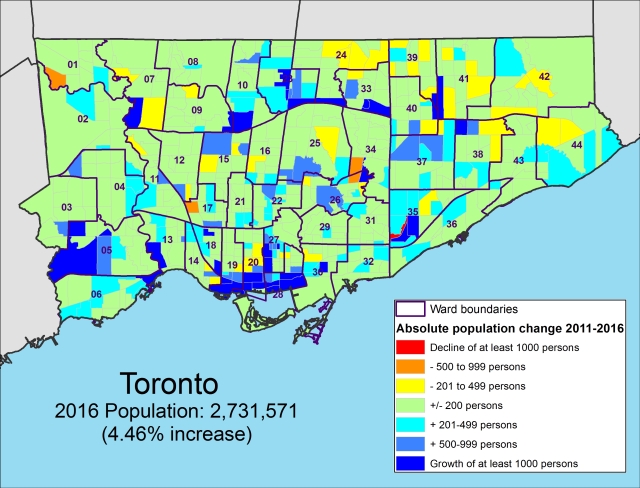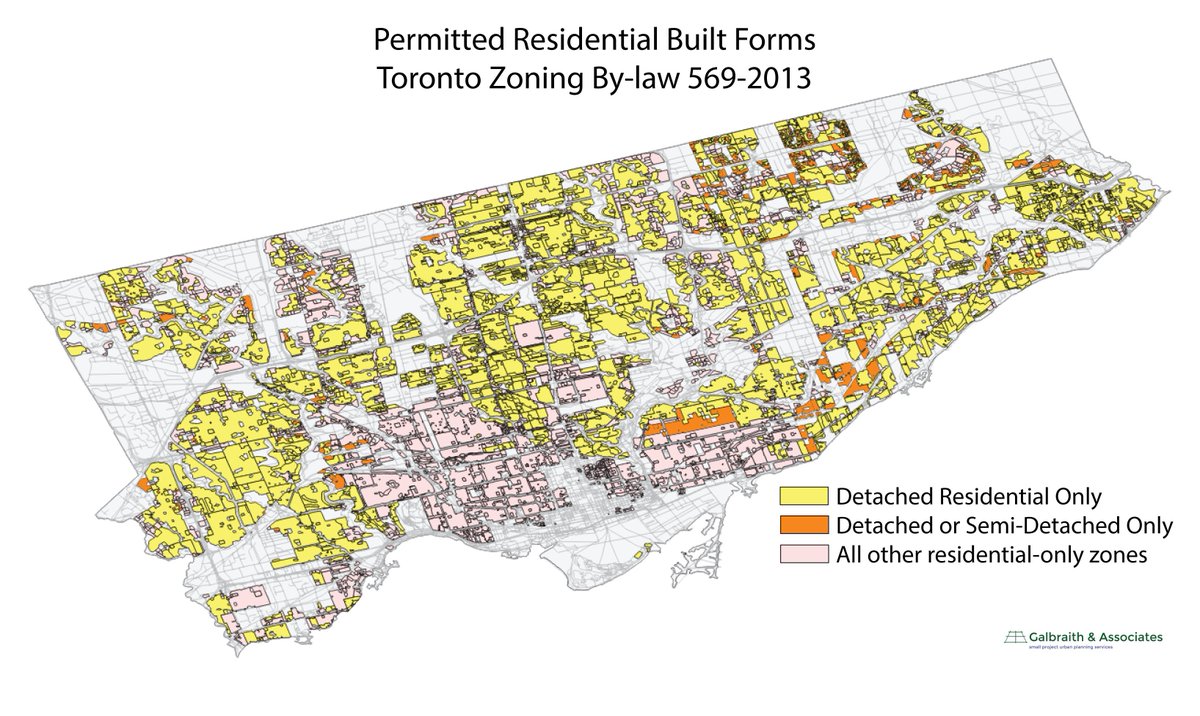adma
Superstar
And also, to some degree the 'burbs are getting a bit "built out" within existing designated growth boundaries; which together with the condo/intensification boom in the 416 has led to something closer to "parity".
Speaking of that, I wonder... has any of the explosive office growth we’ve seen Downtown spilled into the suburbs?
I assume that Downtown has exceeded growth relative to the 2031 growth projections in the 2006 Ontario Populations Projections Update from the Ministry of Finance.Population and Employment growth in Downtown Toronto has accelerated, and has already exceeded 2031 forecasts. Population growth is also very high in the Downtown; however population density itself is more diffused, with pockets generally along existing subway lines as well as in neighbourhoods with lower average household incomes. [p. 19]

High office growth in the core only bolsters the need for RER - as a commuter feeder system to the hyper-job cluster that is downtown.Related tidbit from the Ontario Line Business Case:
I assume that Downtown has exceeded growth relative to the 2031 growth projections in the 2006 Ontario Populations Projections Update from the Ministry of Finance.
Looking elsewhere in the 2006 report, we can see how severely the Province has underestimated the growth of the City of Toronto. The city was projected to add approximately 15,000 people annually, to reach a population of 3.05 Million in 2031. We've now exceeded the 2031 target in 2018-2019, growing by 28,000 people annually, nearly 2x faster than the projections produced in 2006.
View attachment 196562
The bulk of this growth is concentrated in the Downtown Core, with high growth also in Etobicoke Centre and North York Centre. Note that this is from 2016, and I suspect Downtown has absorbed even more of that growth recently :

Source: mapping-torontos-population-growth
I'm really concerned about the planning implications of these inaccurate growth projections. The infrastructure we have planned for Toronto of 2031 is not designed to accommodate a population that could very well exceed 3.5 Million by that point (assuming we continue to add 28,000 people annually, as we have between now and 2006). The adequacy of our Downtown streetcar fleet concerns me the most, but this impacts every aspect of planning across the city. Also, what does the business case look like for a lot of these suburban infrastructure expansions (RER included), if office growth in those regions isn't as high as anticipated?
Also keep in mind that the bulk of the growth since 2006 has been within the past 5 years or so, where we've seen growth of 50,000 to 100,000 people annually. If those numbers are sustained, in an high-growth scenario we could be adding another 900,000 people by 2031, for a population of more or less 4 Million. I don't really expect those numbers to be sustained, (3.4 to 3.7 Million is a lot more reasonable for 2031) but it's no longer a scenario that is out of the realm of possibility, especially with the massive growth in Downtown office space planned within the next 5 years inducing even more people to move into the City of Toronto. The success of RER is going to be critical to keep the growth we see in the City of Toronto under control.
The way the Growth Plan was written is actually quite funny - it spoke of intensification, but then set it's growth projections almost as if most development would still be suburban greenfield. I think it's biggest fatal flaw was that it presumed that as intensification rates increased, growth would shift to intensified sites within the same municipality. For example, instead of Brampton building subdivisions, it would start building high-rises. It failed to realize that a big reason people move to the suburbs is for low-rise greenfield housing stock. If they are going to live in a condo, they will live in a more urban location. It also failed to predict that the suburban office market would crater with the shift to vast gains in downtown employment.
I agree that having intensification occur in Toronto is much better overall. Condos in Downtown Mississauga most assuredly produce higher transit ridership and lower rates of vehicle use than a house on the edge of Mississauga, but a condo at King and Bathurst is going to produce almost 0 vehicle trips, and support even more sustainable forms of transportation than transit, walking and cycling.Makes sense. If I’m in the market for a condo, I’m going to favour just about anywhere in Toronto over Brampton.
Anyways I feel that having most of GTA’s intensification in the City of Toronto is ultimately a good thing, for fiscal sustainability, ecological sustainability and transport. A problem with these 905 intensification plans is that these intensified lands just end up being highly auto dependant, since people living there are going to need cars to travel pretty much anywhere outside of the small intensified area.
City Council this month approved a motion to investigate allowing more so-called “missing middle” developments on yellowbelt lands within the City of Toronto. Yellowbelt developments should theoretically be more family oriented (larger units, quieter streets, more access to green space and similar amenities compared to condos). Assuming the city eases yellowbelt restrictions, this could have the effect of suppressing demand for greenfield developments in the 905 (in favour of Toronto yellowbelt developments), as those greenfield developments are also primarily targeted towards the family-oriented market. Only time will tell; hopefully the City moves quickly on this matter.
Makes sense. If I’m in the market for a condo, I’m going to favour just about anywhere in Toronto over Brampton.
Anyways I feel that having most of GTA’s intensification in the City of Toronto is ultimately a good thing, for fiscal sustainability, ecological sustainability and transport. A problem with these 905 intensification plans is that these intensified lands just end up being highly auto dependant, since people living there are going to need cars to travel pretty much anywhere outside of the small intensified area.
City Council this month approved a motion to investigate allowing more so-called “missing middle” developments on yellowbelt lands within the City of Toronto. Yellowbelt developments should theoretically be more family oriented (larger units, quieter streets, more access to green space and similar amenities compared to condos). Assuming the city eases yellowbelt restrictions, this could have the effect of suppressing demand for greenfield developments in the 905 (in favour of Toronto yellowbelt developments), as those greenfield developments are also primarily targeted towards the family-oriented market. Only time will tell; hopefully the City moves quickly on this matter.
Where are these yellow belt areas?

Makes sense. If I’m in the market for a condo, I’m going to favour just about anywhere in Toronto over Brampton.
Anyways I feel that having most of GTA’s intensification in the City of Toronto is ultimately a good thing, for fiscal sustainability, ecological sustainability and transport. A problem with these 905 intensification plans is that these intensified lands just end up being highly auto dependant, since people living there are going to need cars to travel pretty much anywhere outside of the small intensified area.
City Council this month approved a motion to investigate allowing more so-called “missing middle” developments on yellowbelt lands within the City of Toronto. Yellowbelt developments should theoretically be more family oriented (larger units, quieter streets, more access to green space and similar amenities compared to condos). Assuming the city eases yellowbelt restrictions, this could have the effect of suppressing demand for greenfield developments in the 905 (in favour of Toronto yellowbelt developments), as those greenfield developments are also primarily targeted towards the family-oriented market. Only time will tell; hopefully the City moves quickly on this matter.
Seems like we’re witnessing this effect here in Toronto as well, perhaps at the expense at other GTHA and Canadian cities (either a good or bad thing, depending on POV):
Why America’s Richest Cities Keep Getting Richer
I'd say your best bet would be to try and get within the commutershed of these primate cities. where possible through infrastructure development (particularly rail).
AoD




